Drawing cartoon children requires a keen understanding of proportions to capture their youthful essence accurately. Perfecting these proportions is crucial for creating characters that are both appealing and believable. Unlike adults, children’s bodies have distinct characteristics that set them apart, such as larger heads relative to their bodies and softer facial features. This guide will provide you with step-by-step instructions and tips to help you draw cartoon children with perfect proportions, whether you’re a beginner or looking to refine your skills.

Understanding Child Proportions
Head-to-Body Ratio
One of the most significant differences between children and adults is the head-to-body ratio. Children’s heads are proportionally larger compared to their bodies.
- Infants (0-2 years): Approximately 3 to 4 heads tall.
- Toddlers (2-4 years): About 4 to 5 heads tall.
- Young Children (5-7 years): Around 5 to 6 heads tall.
- Older Children (8-12 years): Between 6 to 7 heads tall.
Tip: In cartooning, you can exaggerate these proportions slightly to enhance the cuteness or stylistic appeal of your characters.
Facial Proportions
- Eyes: Larger and positioned lower on the face.
- Nose and Mouth: Smaller and closer together.
- Ears: Align between the eye line and the bottom of the nose.
- Chin: Softer and less pronounced.
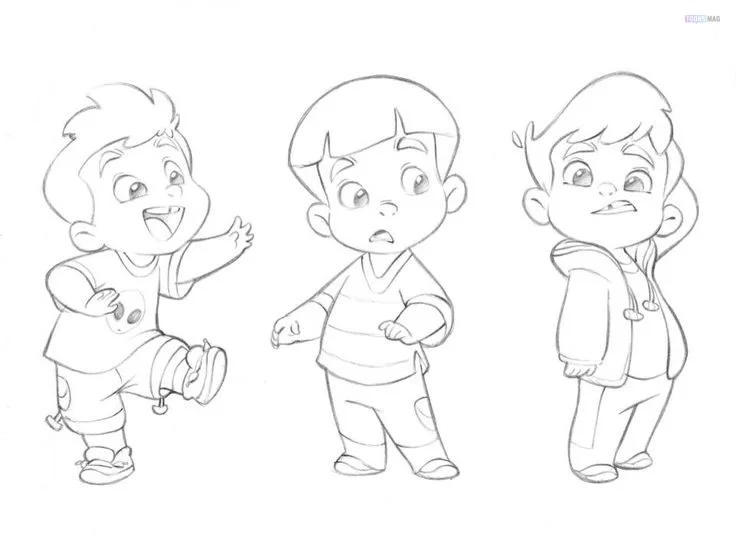
Step-by-Step Guide to Drawing Cartoon Children
Step 1: Sketch Basic Shapes
1. Draw the Head
- Start with a circle for the head.
- Add a vertical line down the center for symmetry.
- Draw a horizontal line halfway down the circle for the eye line.
2. Outline the Face
- For younger children, keep the face round.
- For older children, slightly elongate the face but maintain softness.
3. Add the Neck and Torso
- Draw two short lines downward from the head for the neck.
- Sketch an oval or rectangle for the torso, smaller than that of an adult.
4. Draw the Limbs
- Use simple lines or ovals for arms and legs.
- Remember, children’s limbs are shorter and chubbier.
5. Add Hands and Feet
- Sketch small circles or ovals for hands and feet.
- Keep them proportionally smaller.
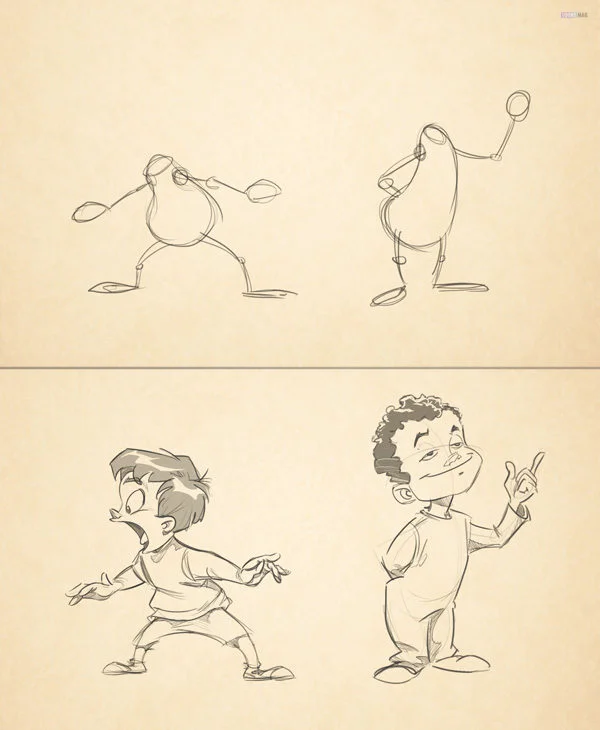
Step 2: Refine Facial Features
1. Eyes
- Place the eyes on the eye line, making them large and expressive.
- Use big circles or ovals.
- Space them slightly wider apart than in adults.
2. Nose
- Draw a small button nose halfway between the eye line and the chin.
- Keep it simple—often, a small curve or dot suffices.
3. Mouth
- Place the mouth closer to the nose.
- Use simple lines to depict different expressions.
4. Ears
- Position ears between the eye line and nose line on each side of the head.
5. Hair
- Add hair using simple, flowing lines.
- Children’s hair is often less detailed.

Step 3: Refine the Body
1. Torso
- Keep the torso short and slightly wider to reflect a child’s body.
2. Arms and Hands
- Thicken the arms slightly.
- Add small hands with minimal details.
3. Legs and Feet
- Thicken the legs to show a child’s stockier build.
- Draw feet as simple shapes.

Step 4: Add Clothing and Details
- Dress your character in age-appropriate clothing.
- Use simple lines and shapes for clothing—overcomplicating can distract from the character.
- Add accessories like hats, toys, or backpacks to enhance personality.
Step 5: Outline and Erase Guidelines
- Go over your sketch with a darker pencil or pen.
- Emphasize the final lines and shapes.
- Erase any unnecessary guidelines.
Step 6: Add Color and Shading (Optional)
- Use vibrant colors for clothing and accessories.
- Add shading to give your character depth.
- Highlight areas where light would naturally hit.
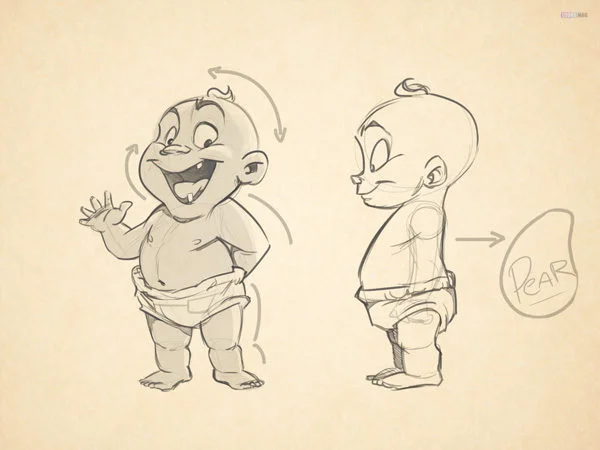
Tips for Achieving Perfect Proportions
Use Reference Images
- Observe real children to understand natural proportions.
- Study photographs or watch cartoons to see how professionals depict children.
Practice Consistently
- Regular practice helps you internalize proportions.
- Try drawing children of different ages to understand how proportions change.
Simplify Complex Features
- In cartooning, less is often more.
- Focus on essential features that convey emotion and personality.
Emphasize Key Characteristics
- Large eyes and heads emphasize youthfulness.
- Soft, rounded shapes make characters appear more childlike.
Pay Attention to Body Language
- Children often have open and expressive body language.
- Incorporate playful poses to reflect their energy.
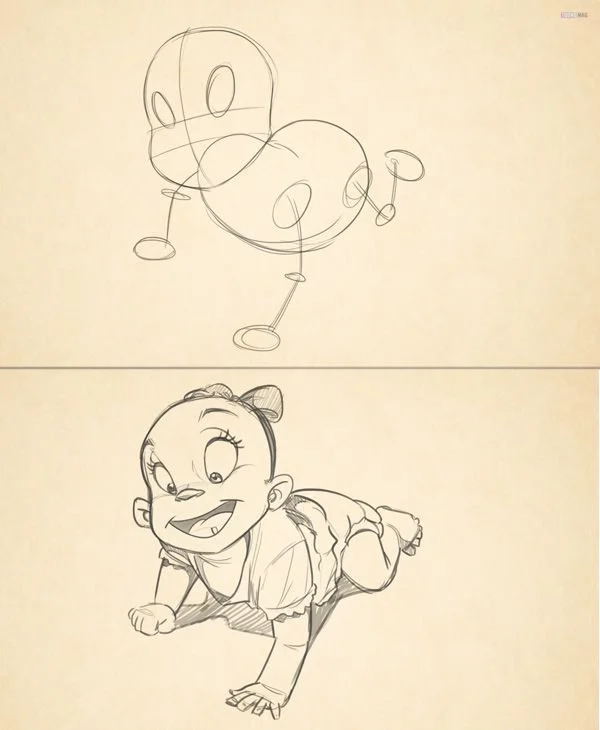
Common Mistakes to Avoid
- Making Limbs Too Long: Remember, children’s arms and legs are proportionally shorter.
- Overloading with Details: Too many details can make the character look cluttered.
- Ignoring Age Differences: Adjust proportions based on the child’s age for accuracy.
Practice Exercises
1. Draw a Series of Heads
- Practice drawing heads with different head-to-body ratios.
- Focus on positioning facial features correctly.
2. Create Emotion Charts
- Draw your character showing various emotions.
- Pay attention to how facial features change with each expression.
3. Sketch Different Poses
- Draw your character in different activities like running, jumping, or playing.
- This helps understand how body proportions look in motion.
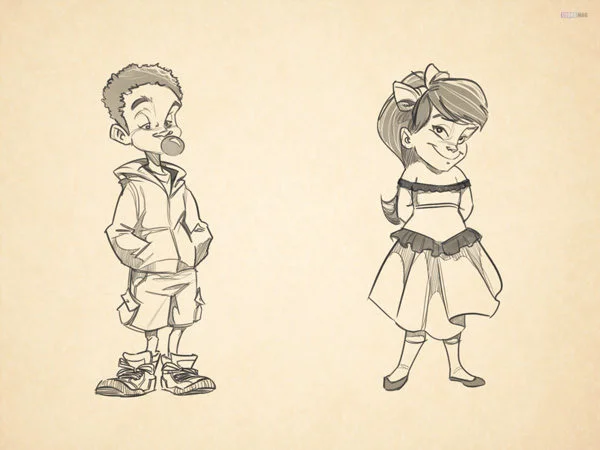
Draw Cartoon Children
Drawing cartoon children with perfect proportions combines understanding anatomy with creative expression. By following these guidelines and practicing regularly, you’ll develop the skills needed to create charming and realistic cartoon children.
Final Thoughts
Remember, perfection comes with practice and patience. Don’t be afraid to experiment and make adjustments as you learn. Each drawing is a step forward in your artistic journey.
Call to Action
Ready to bring your cartoon children to life? Grab your drawing tools and start practicing today! Share your progress and creations with others to gain feedback and inspiration.
This may sound a bit difficult if you are not familiar with the standard proportions of the human body – and that’s true of most budding cartoonists. So, to start with, it helps to understand what the ratios are, and then learn them so that you can apply an appropriate amount of exaggeration to suit your drawing objective. In this article I’ll describe how to measure the proportions and what the different values are for the range of people from babies of one-year-old through to full adult.
This post was created with our nice and easy submission form. Create your post!










3 Comments